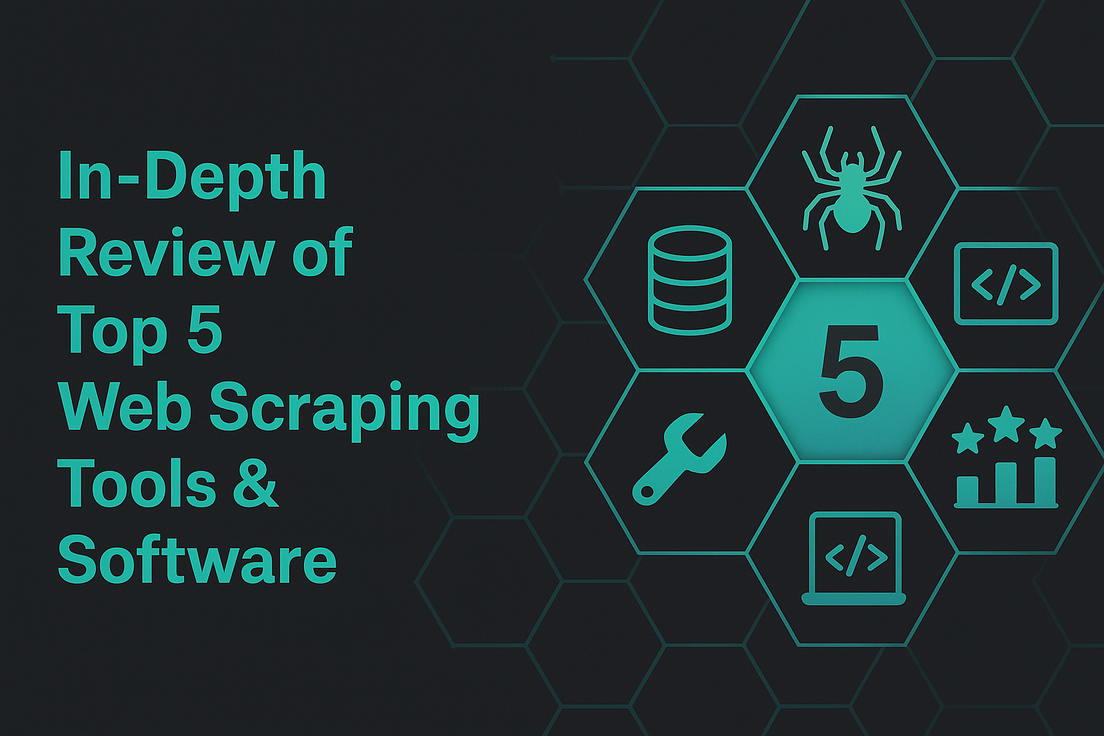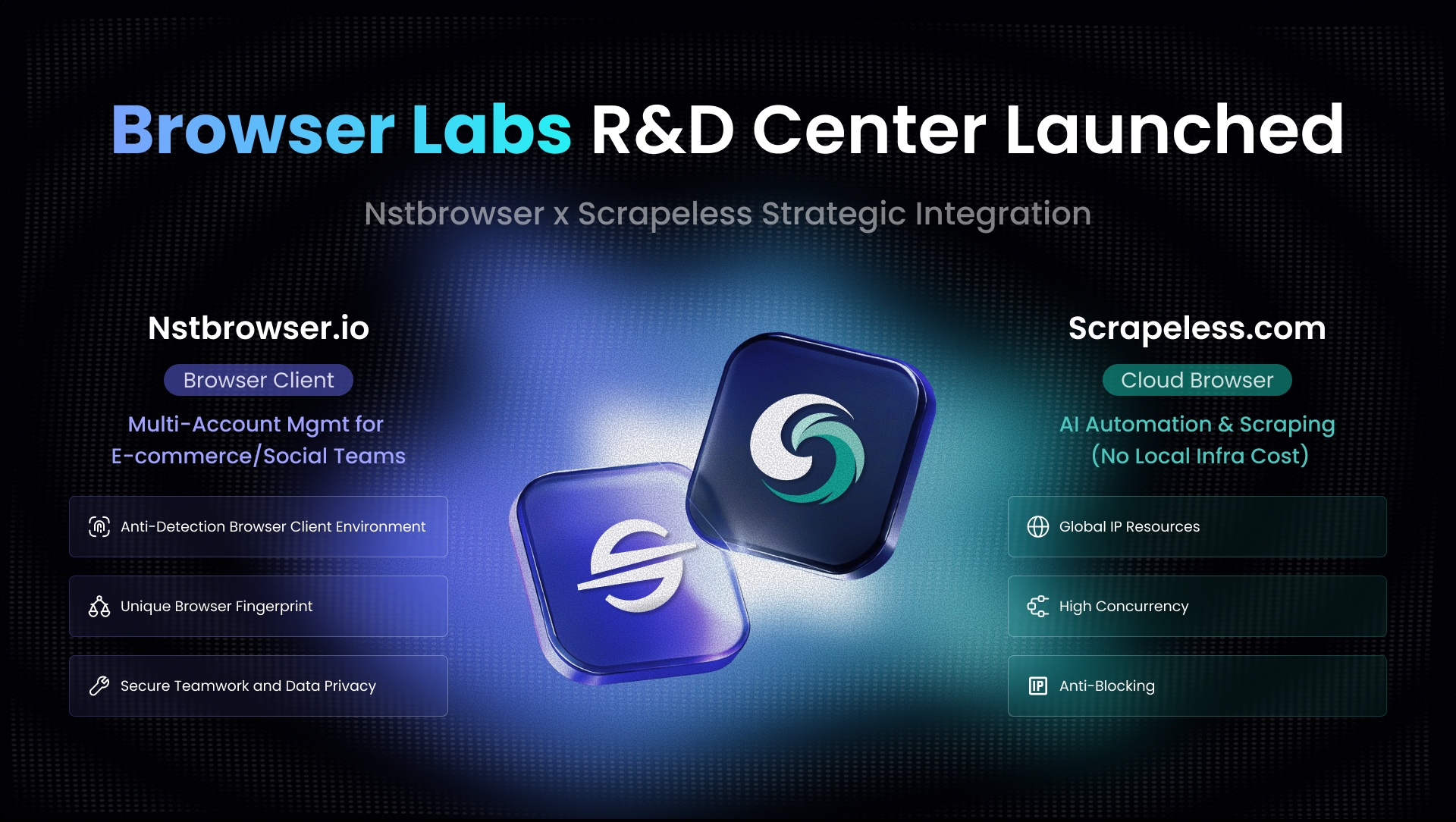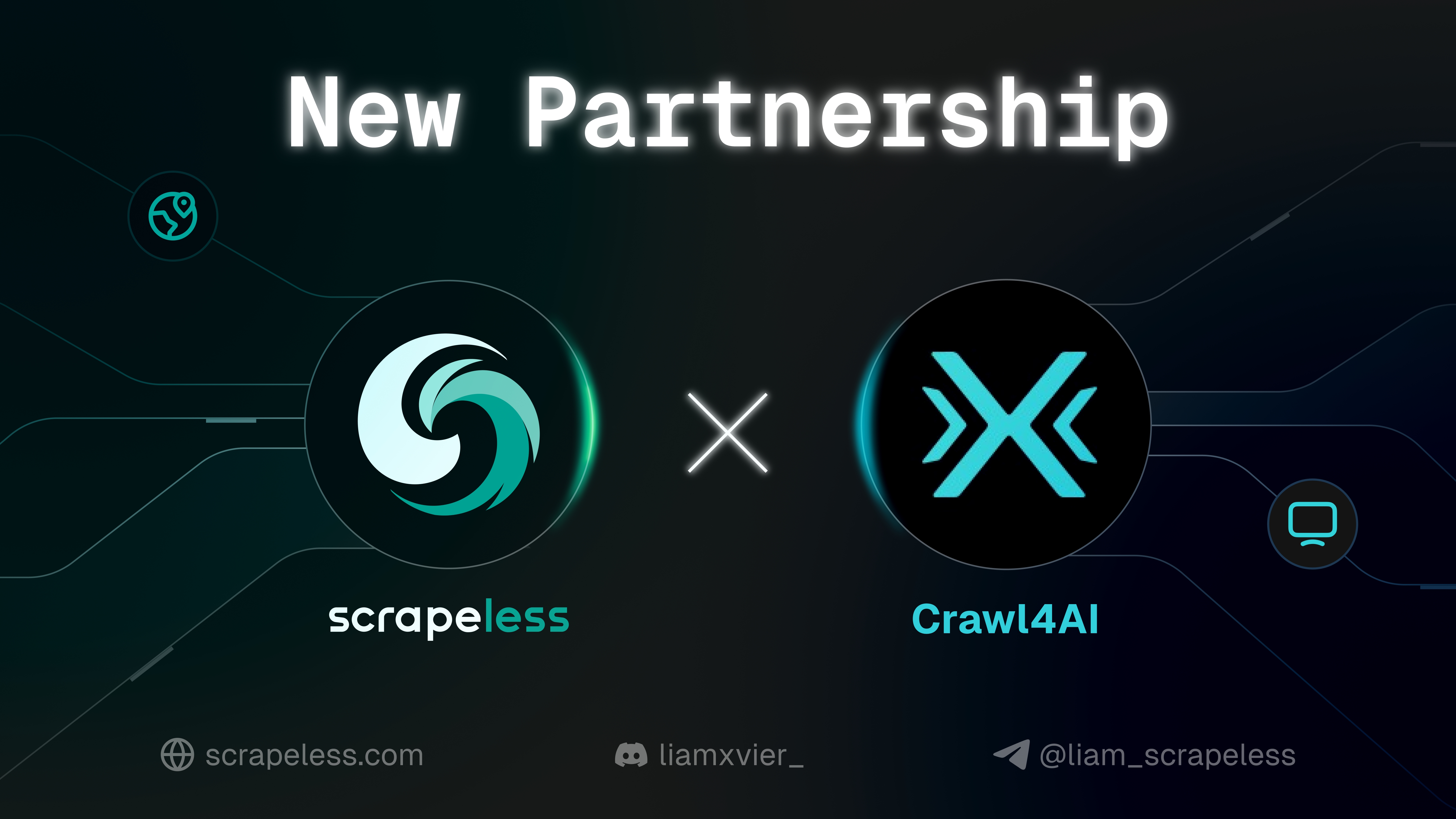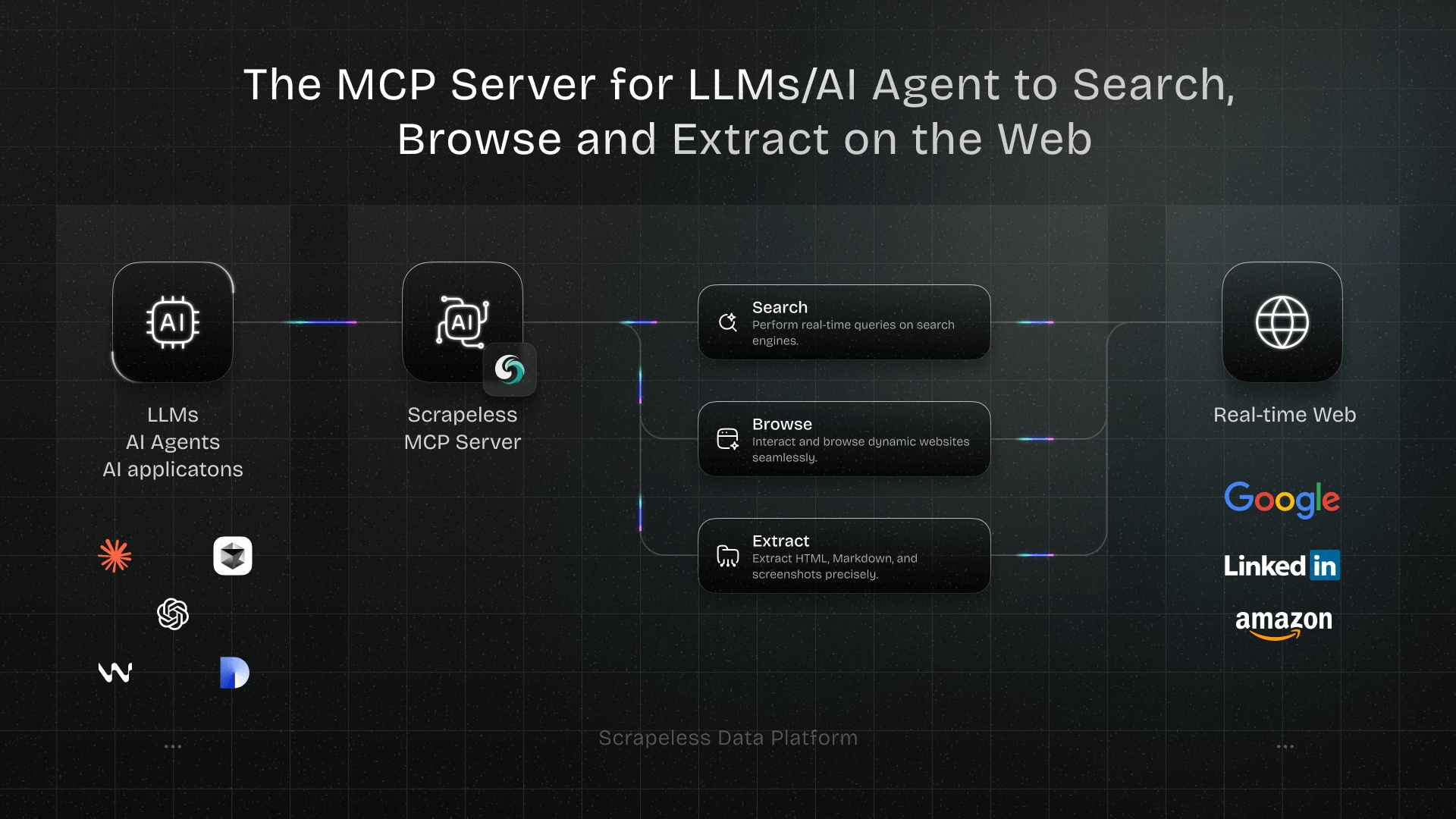In-Depth Review of Top 5 Web Scraping Tools & Software
Advanced Data Extraction Specialist
Key Takeaways
- Web scraping tools vary widely, from powerful coding frameworks to user-friendly no-code solutions, each suited for different needs.
- Choosing the right tool depends on project complexity, technical skill, scalability requirements, and budget.
- This guide provides an in-depth review of the top 5 web scraping tools and software, highlighting their strengths, weaknesses, and ideal use cases.
- Advanced web scraping often requires solutions that can handle anti-bot measures, JavaScript rendering, and proxy management.
- Scrapeless offers a comprehensive, managed API solution that simplifies complex scraping tasks, complementing both code-based and no-code approaches.
Introduction
In the digital age, data is the new oil, and web scraping is the refinery that extracts it from the vast ocean of the internet. Whether for market research, competitive analysis, lead generation, or academic studies, the ability to efficiently collect data from websites is invaluable. However, the landscape of web scraping is diverse and constantly evolving, with a myriad of tools and software available, each promising to simplify the extraction process. Choosing the right tool can be daunting, as it requires balancing technical capabilities, ease of use, scalability, and cost. This in-depth review aims to demystify the options by examining the top 5 web scraping tools and software available today. We will delve into their features, pros, cons, and ideal scenarios, providing you with the insights needed to make an informed decision. Furthermore, we will explore how a robust, managed solution like Scrapeless can serve as an essential partner, enhancing the capabilities of these tools and overcoming common scraping challenges.
What are Web Scraping Tools & Software?
Web scraping tools and software are applications or libraries designed to automate the process of extracting data from websites. They range from simple command-line utilities to complex, cloud-based platforms. Fundamentally, these tools interact with web pages, parse their content (usually HTML), and extract specific information based on predefined rules or patterns. The extracted data can then be stored in various formats, such as CSV, JSON, or databases, for further analysis or use.
These tools are essential because manually copying data from websites is impractical for large datasets and prone to human error. Automation allows for speed, accuracy, and the ability to collect data at scale, making it a cornerstone of data-driven decision-making across many industries.
How to Choose the Right Web Scraping Tool?
Selecting the optimal web scraping tool involves considering several factors:
- Project Complexity: Simple, static websites might only need basic libraries, while dynamic, JavaScript-heavy sites require more advanced solutions like headless browsers or specialized APIs.
- Technical Skill Level: Developers might prefer coding frameworks for maximum control, while non-technical users would benefit from no-code visual tools.
- Scalability: For large-scale projects requiring millions of requests, a tool or service that handles proxy rotation, CAPTCHA solving, and distributed scraping is crucial.
- Anti-Scraping Measures: Websites often employ bot detection. The chosen tool should have strategies to bypass these, such as user-agent rotation, proxy management, or JavaScript rendering.
- Budget: Tools range from free open-source libraries to expensive enterprise solutions. Consider the total cost of ownership, including infrastructure and maintenance.
- Data Output Format: Ensure the tool can deliver data in a format compatible with your downstream processes.
- Maintenance: How much effort is required to maintain the scraper when website layouts change?
With these considerations in mind, let's explore the top 5 web scraping tools and software.
Top 5 Web Scraping Tools & Software
1. Scrapeless: The Managed Web Scraping API
Scrapeless is a comprehensive, managed web scraping API designed to simplify data extraction by handling all the complexities of web access. It acts as an intermediary, allowing you to send requests and receive clean, structured data without worrying about proxies, CAPTCHAs, anti-bot detection, or JavaScript rendering. Scrapeless is particularly valuable for projects requiring high reliability and scalability [1].
Key Features:
- Anti-Bot Bypass: Automatically handles and bypasses advanced anti-bot systems, CAPTCHAs, and IP blocks.
- Global Proxy Network: Provides access to a vast pool of rotating residential and datacenter proxies.
- JavaScript Rendering: Fully renders dynamic websites to ensure all content is accessible.
- Managed Infrastructure: Offloads the burden of maintaining scraping infrastructure.
- Simple API Integration: Easy to integrate with any programming language via a straightforward API.
- Cost-Effective Scaling: Pay-as-you-go model, optimized for successful requests.
Pros:
- High Reliability: Ensures consistent data extraction by overcoming common web scraping obstacles.
- Scalability: Built for large-scale operations without requiring users to manage infrastructure.
- Ease of Use: Simplifies complex scraping tasks into simple API calls.
- Focus on Data: Allows developers to focus on data processing and analysis rather than infrastructure management.
- Reduces Maintenance: Minimizes the need to update scrapers due to website changes or anti-bot updates.
Cons:
- Cost for High Volume: While efficient, costs can accumulate for extremely high volumes of requests.
- Less Control: Offers less granular control over browser behavior compared to direct headless browser automation.
- Dependency on Service: Relies on the Scrapeless service for operation.
Best For: Businesses, developers, and data scientists who need reliable, scalable, and hassle-free web scraping, especially for websites with strong anti-bot measures or dynamic content. Ideal for those who want to focus on data utilization rather than infrastructure management.
2. Scrapy: The Powerful Python Framework
Scrapy is an open-source, fast, and powerful Python framework for web crawling and web scraping. It allows you to build sophisticated spiders that can efficiently extract data from websites. Scrapy is ideal for developers who need fine-grained control over their scraping process and are comfortable with Python programming [1].
Key Features:
- Asynchronous Architecture: Built on Twisted, enabling high performance and concurrent requests.
- Robust Selectors: Supports XPath and CSS selectors for efficient data extraction.
- Middleware System: Allows for custom processing of requests and responses (e.g., user-agent rotation, proxy integration, cookie handling).
- Item Pipelines: Provides a clean way to process and store scraped items (e.g., validation, database storage).
- Extensible: Highly customizable with a rich set of signals and extensions.
Pros:
- High Performance: Designed for speed and efficiency, capable of handling large-scale projects.
- Flexible and Powerful: Offers extensive control over the scraping process.
- Rich Ecosystem: Large community support, extensive documentation, and many available extensions.
- Built-in Features: Handles request scheduling, retries, and redirects automatically.
Cons:
- Steep Learning Curve: Requires solid Python knowledge and understanding of its architecture.
- Complex Setup: Can be challenging to set up and configure for beginners.
- Anti-Bot Bypass: Does not inherently handle advanced anti-bot measures; requires custom middleware or integration with external services.
- JavaScript Rendering: Not designed for JavaScript rendering out-of-the-box; requires integration with headless browsers like Playwright or Selenium.
Best For: Experienced Python developers, large-scale data extraction projects, and complex crawling needs where custom logic is essential.
3. Playwright: Modern Headless Browser Automation
Playwright is a modern, open-source automation library developed by Microsoft that enables reliable end-to-end testing and web scraping across Chromium, Firefox, and WebKit with a single API. It excels at handling dynamic, JavaScript-rendered content, making it a go-to choice for scraping modern websites that traditional HTTP request libraries struggle with [4].
Key Features:
- Cross-Browser Support: Automates Chromium, Firefox, and WebKit (Safari) with one API.
- Auto-Waiting: Automatically waits for elements to be ready before performing actions, simplifying script logic.
- Headless and Headful Modes: Can run browsers with or without a UI.
- Context Isolation: Provides isolated browser contexts for parallel execution and session management.
- Powerful Selectors: Supports CSS, XPath, and text-based selectors, along with Playwright-specific selectors.
- Network Interception: Allows modification of network requests and responses.
Pros:
- Excellent for Dynamic Content: Renders JavaScript-heavy pages accurately.
- Fast and Reliable: Designed for speed and stability, with built-in auto-waiting.
- Modern API: Intuitive and easy to use for developers familiar with modern web technologies.
- Strong Debugging Tools: Offers trace viewers, screenshots, and video recording for debugging.
- Stealth Capabilities: Better at evading bot detection compared to older headless browser solutions.
Cons:
- Resource Intensive: Running full browser instances consumes more CPU and memory than HTTP-based scrapers.
- Setup Complexity: Requires installing browser binaries, which can add to initial setup.
- Scalability Challenges: Managing multiple browser instances for large-scale scraping can be complex and costly without external infrastructure.
- Proxy Integration: Requires manual configuration or integration with proxy services.
Best For: Scraping dynamic websites, web testing, and scenarios requiring full browser rendering. Ideal for developers seeking a modern, high-performance automation tool.
4. BeautifulSoup & Requests: The Pythonic Duo for Simplicity
BeautifulSoup, often paired with the requests library, forms a fundamental and highly popular combination for web scraping in Python. requests handles making HTTP requests to fetch web page content, while BeautifulSoup parses the HTML/XML documents, making it easy to navigate, search, and modify the parse tree [6]. This duo is excellent for static websites and simpler scraping tasks.
Key Features:
requests: Simple and elegant HTTP library for Python, handling various request types, headers, and authentication.- BeautifulSoup: Parses HTML/XML, creating a parse tree that can be searched using various methods (tag name, CSS class, ID, etc.).
- Easy to Learn: Both libraries have straightforward APIs and are beginner-friendly.
- Lightweight: Minimal dependencies and low resource consumption.
Pros:
- Simplicity and Ease of Use: Very easy to get started with, even for beginners.
- Fast for Static Content: Highly efficient for websites that don't rely heavily on JavaScript.
- Flexible Parsing: BeautifulSoup provides powerful and Pythonic ways to extract data.
- Widely Adopted: Large community and extensive resources available.
Cons:
- No JavaScript Rendering: Cannot execute JavaScript, making it unsuitable for dynamic websites.
- No Anti-Bot Bypass: Does not inherently handle CAPTCHAs, IP bans, or other anti-scraping measures.
- Manual Management: Requires manual handling of sessions, cookies, and retries.
- Scalability Limitations: Not designed for large-scale, distributed scraping without significant custom development.
Best For: Beginners, scraping static websites, small to medium-sized projects, and educational purposes where simplicity and direct HTML parsing are key.
5. Octoparse: The No-Code Visual Scraper
Octoparse is a popular no-code web scraping tool designed for users without programming knowledge. It provides a visual point-and-click interface to build scrapers, making it accessible to business users, marketers, and researchers who need to extract data without writing a single line of code [13].
Key Features:
- Point-and-Click Interface: Visually select data fields and define scraping rules.
- Cloud Platform: Runs scrapers in the cloud, freeing up local resources and enabling scalability.
- Scheduled Scraping: Automate data extraction at predefined intervals.
- IP Rotation: Offers built-in IP rotation to avoid blocks.
- Handles Dynamic Content: Can render JavaScript and handle AJAX-loaded data.
- Various Export Formats: Exports data to Excel, CSV, JSON, databases, and APIs.
Pros:
- Extremely User-Friendly: No coding required, making it accessible to a broad audience.
- Fast Deployment: Quickly build and deploy scrapers with its intuitive interface.
- Cloud-Based: Offloads scraping tasks to the cloud, ensuring continuous operation.
- Handles Complex Websites: Capable of scraping dynamic content and managing some anti-bot measures.
- Customer Support: Offers dedicated support and tutorials.
Cons:
- Limited Customization: Less flexible than code-based solutions for highly specific or complex scraping logic.
- Cost: Can become expensive for high-volume scraping or advanced features.
- Vendor Lock-in: Dependent on the platform for scraper execution and maintenance.
- Performance: May not match the raw speed and efficiency of optimized code-based frameworks for certain tasks.
Best For: Non-technical users, small to medium businesses, market researchers, and anyone needing quick data extraction without coding. Ideal for projects where visual configuration is preferred over programming.
Comparison Summary: Top 5 Web Scraping Tools & Software
| Feature / Aspect | Scrapy | Playwright | BeautifulSoup & Requests | Octoparse | Scrapeless |
|---|---|---|---|---|---|
| Type | Python Framework | Headless Browser Library | Python Libraries (HTTP + Parser) | No-Code Visual Tool | Managed API Service |
| Technical Skill | High (Python) | Medium-High (Python/JS) | Low-Medium (Python) | Low (No-Code) | Low (API Integration) |
| JavaScript Rendering | No (requires integration) | Yes (Built-in) | No | Yes (Built-in) | Yes (Built-in) |
| Anti-Bot Bypass | Manual/Custom Middleware | Moderate (with stealth) | No | Moderate (built-in IP rotation) | High (Managed) |
| Proxy Management | Manual/Custom Middleware | Manual Configuration | Manual Configuration | Built-in | Built-in (Managed) |
| Scalability | High (with custom setup) | Medium (resource intensive) | Low (manual management) | High (cloud-based) | High (managed infrastructure) |
| Ease of Use | Low | Medium | High | Very High | High |
| Cost | Free (open-source, infra cost) | Free (open-source, infra cost) | Free (open-source, infra cost) | Paid (tiered plans) | Paid (usage-based) |
| Ideal Use Case | Complex, large-scale, custom scraping | Dynamic websites, testing, modern web apps | Static sites, small projects, learning | Non-technical users, quick data extraction | Reliable, scalable, complex scraping with anti-bot |
Why Scrapeless is Your Essential Partner for Web Scraping
In the diverse world of web scraping, each tool has its strengths and weaknesses. While Scrapy offers unparalleled control for developers, Playwright excels at dynamic content, and Octoparse provides a no-code entry point, a common thread runs through all complex scraping endeavors: the persistent challenge of web access. Websites are increasingly sophisticated in their anti-bot measures, making it difficult for even the most advanced tools to consistently extract data without encountering blocks, CAPTCHAs, or IP bans.
This is precisely where Scrapeless emerges as an essential partner, complementing and enhancing the capabilities of any web scraping strategy. Scrapeless is not just another tool; it's a comprehensive, managed API service that abstracts away the most frustrating aspects of web scraping infrastructure. By integrating Scrapeless, you can:
- Guaranteed Access: Scrapeless automatically handles advanced anti-bot detection, CAPTCHAs, and IP rotation, ensuring your requests reach the target website successfully.
- Full JavaScript Rendering: For dynamic websites, Scrapeless renders pages completely, providing you with the final HTML content, regardless of how complex the JavaScript is.
- Scalability Without Overhead: Forget about managing proxy pools, maintaining headless browser farms, or dealing with server infrastructure. Scrapeless scales automatically to meet your demands, allowing you to focus on data utilization.
- Simplified Workflow: Integrate with a single API call, reducing development time and maintenance efforts. This means you can use your preferred scraping tool (Scrapy, Playwright, or even BeautifulSoup) for parsing, while Scrapeless ensures reliable data delivery.
- Cost-Efficiency: Pay only for successful requests, optimizing your budget and avoiding wasted resources on blocked attempts.
By leveraging Scrapeless, you transform your web scraping projects from a constant battle against website defenses into a streamlined, efficient, and highly reliable data acquisition pipeline. It allows developers to harness the power of their chosen tools without being bogged down by the complexities of web access, and empowers non-technical users to achieve robust scraping results.
Conclusion and Call to Action
The world of web scraping offers a rich array of tools and software, each with unique advantages for different users and project requirements. From the developer-centric power of Scrapy and Playwright to the user-friendly visual interface of Octoparse, and the foundational simplicity of BeautifulSoup & Requests, there's a solution for nearly every need. However, the journey of extracting data from the internet is rarely straightforward, often fraught with challenges like anti-bot systems, dynamic content, and the need for scalable infrastructure.
This is where the strategic integration of a managed web scraping API like Scrapeless becomes not just beneficial, but essential. Scrapeless acts as the bridge between your chosen scraping logic and the complexities of the web, ensuring reliable access, handling anti-bot measures, and providing fully rendered content. By combining the strengths of your preferred tools with the robust infrastructure of Scrapeless, you can achieve unparalleled efficiency, scalability, and success in your data extraction endeavors.
Ready to overcome web scraping challenges and unlock reliable data access?
Discover how Scrapeless can elevate your web scraping projects and start your free trial today!
FAQ (Frequently Asked Questions)
Q1: What is the best web scraping tool for beginners?
A1: For beginners, no-code tools like Octoparse or ParseHub are excellent choices due to their visual, point-and-click interfaces. If you prefer a code-based approach and are learning Python, the combination of requests and BeautifulSoup is a great starting point for static websites.
Q2: Which web scraping tool is best for dynamic websites?
A2: For dynamic websites that rely heavily on JavaScript, headless browser automation tools like Playwright or Selenium are highly effective as they can render pages completely. Managed API services like Scrapeless also excel here, as they handle JavaScript rendering automatically on their infrastructure.
Q3: Can web scraping tools bypass all anti-bot measures?
A3: No single tool can guarantee bypassing all anti-bot measures indefinitely, as website defenses are constantly evolving. However, advanced tools and services like Scrapeless, which employ sophisticated techniques such as IP rotation, user-agent management, and CAPTCHA solving, offer a very high success rate against most anti-bot systems.
Q4: Are open-source web scraping tools truly free?
A4: Open-source tools like Scrapy, Playwright, and BeautifulSoup are free in terms of software licensing. However, running them for large-scale projects often incurs costs for infrastructure (servers, proxies), maintenance, and development time. Managed API services, while having a direct cost, can often be more cost-effective in the long run by reducing these operational overheads.
Q5: How does Scrapeless compare to other web scraping tools?
A5: Scrapeless is a managed web scraping API service, which differentiates it from frameworks (Scrapy), libraries (BeautifulSoup), or headless browsers (Playwright). Instead of providing tools to build a scraper, Scrapeless provides a service that handles the entire web access layer (proxies, anti-bot, JavaScript rendering), allowing you to use your preferred parsing logic or integrate it into any existing setup for reliable data delivery.
" rel="nofollow">Octoparse Official Site
At Scrapeless, we only access publicly available data while strictly complying with applicable laws, regulations, and website privacy policies. The content in this blog is for demonstration purposes only and does not involve any illegal or infringing activities. We make no guarantees and disclaim all liability for the use of information from this blog or third-party links. Before engaging in any scraping activities, consult your legal advisor and review the target website's terms of service or obtain the necessary permissions.



